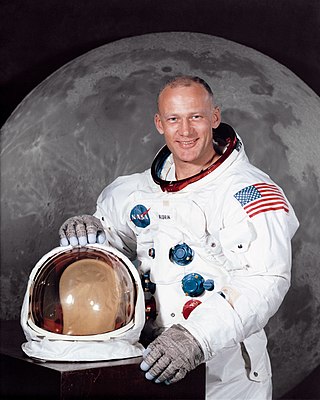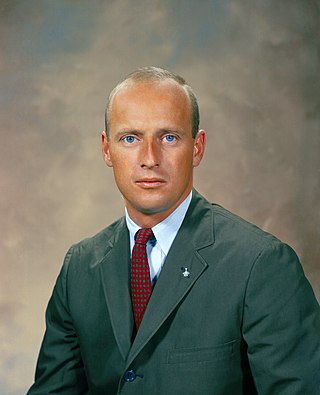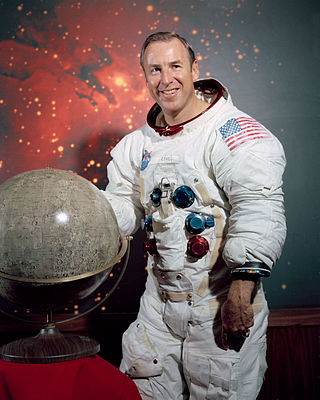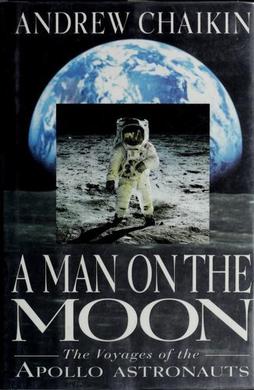Related Research Articles

Apollo 8 was the first crewed spacecraft to leave low Earth orbit and the first human spaceflight to reach the Moon. The crew orbited the Moon ten times without landing, and then departed safely back to Earth. These three astronauts—Frank Borman, James Lovell, and William Anders—were the first humans to witness and photograph the far side of the Moon and an Earthrise.

The Apollo program, also known as Project Apollo, was the third United States human spaceflight program carried out by the National Aeronautics and Space Administration (NASA), which succeeded in preparing and landing the first humans on the Moon from 1968 to 1972. It was first conceived in 1960 during President Dwight D. Eisenhower's administration as a three-person spacecraft to follow the one-person Project Mercury, which put the first Americans in space. Apollo was later dedicated to President John F. Kennedy's national goal for the 1960s of "landing a man on the Moon and returning him safely to the Earth" in an address to Congress on May 25, 1961. It was the third US human spaceflight program to fly, preceded by the two-person Project Gemini conceived in 1961 to extend spaceflight capability in support of Apollo.

Apollo 13 was the seventh crewed mission in the Apollo space program and the third meant to land on the Moon. The craft was launched from Kennedy Space Center on April 11, 1970, but the lunar landing was aborted after an oxygen tank in the service module (SM) failed two days into the mission. The crew instead looped around the Moon and returned safely to Earth on April 17. The mission was commanded by Jim Lovell, with Jack Swigert as command module (CM) pilot and Fred Haise as Lunar Module (LM) pilot. Swigert was a late replacement for Ken Mattingly, who was grounded after exposure to rubella.

Apollo 9 was the third human spaceflight in NASA's Apollo program. Flown in low Earth orbit, it was the second crewed Apollo mission that the United States launched via a Saturn V rocket, and was the first flight of the full Apollo spacecraft: the command and service module (CSM) with the Lunar Module (LM). The mission was flown to qualify the LM for lunar orbit operations in preparation for the first Moon landing by demonstrating its descent and ascent propulsion systems, showing that its crew could fly it independently, then rendezvous and dock with the CSM again, as would be required for the first crewed lunar landing. Other objectives of the flight included firing the LM descent engine to propel the spacecraft stack as a backup mode, and use of the portable life support system backpack outside the LM cabin.

Apollo 10 was a human spaceflight, the fourth crewed mission in the United States Apollo program, and the second to orbit the Moon. NASA described it as a "dress rehearsal" for the first Moon landing, and designated it an "F" mission, intended to test all spacecraft components and procedures short of actual descent and landing. While astronaut John Young remained in the Command and Service Module (CSM) orbiting the Moon, astronauts Thomas Stafford and Gene Cernan flew the Apollo Lunar Module (LM) to within 15.6 kilometers (8.4 nmi) of the lunar surface, the point at which powered descent for landing would begin on a landing mission, before rejoining Young in the CSM. After orbiting the Moon 31 times, Apollo 10 returned safely to Earth; its success enabled the first crewed landing during Apollo 11 two months later.

Apollo 14 was the eighth crewed mission in the United States Apollo program, the third to land on the Moon, and the first to land in the lunar highlands. It was the last of the "H missions", landings at specific sites of scientific interest on the Moon for two-day stays with two lunar extravehicular activities.

Neil Alden Armstrong was an American astronaut and aeronautical engineer who became the first person to walk on the Moon in 1969. He was also a naval aviator, test pilot, and university professor.

Buzz Aldrin is an American former astronaut, engineer and fighter pilot. He made three spacewalks as pilot of the 1966 Gemini 12 mission. As the Lunar Module Eagle pilot on the 1969 Apollo 11 mission, he and mission commander Neil Armstrong were the first two people to land on the Moon.

William Alison Anders is a retired United States Air Force (USAF) major general, former electrical engineer, nuclear engineer, NASA astronaut, and businessman. In December 1968, he was a member of the crew of Apollo 8, the first three people to leave low Earth orbit and travel to the Moon. Along with fellow astronauts Frank Borman and Jim Lovell, Anders circled the Moon ten times, and broadcast live images and commentary back to Earth. During one of the mission's lunar orbits, he took the iconic Earthrise photograph.

Alan LaVern Bean was an American naval officer and aviator, aeronautical engineer, test pilot, NASA astronaut and painter. He was selected to become an astronaut by NASA in 1963 as part of Astronaut Group 3, and was the fourth person to walk on the Moon.

Charles "Pete" Conrad Jr. was an American NASA astronaut, aeronautical engineer, naval officer and aviator, and test pilot, and commanded the Apollo 12 space mission, on which he became the third person to walk on the Moon. Conrad was selected in NASA's second astronaut class in 1962.

James Arthur Lovell Jr. is an American retired astronaut, naval aviator, test pilot and mechanical engineer. In 1968, as command module pilot of Apollo 8, he became, with Frank Borman and William Anders, one of the first three astronauts to fly to and orbit the Moon. He then commanded the Apollo 13 lunar mission in 1970 which, after a critical failure en route, circled the Moon and returned safely to Earth.

Clifton Curtis Williams Jr., was an American naval aviator, test pilot, mechanical engineer, major in the United States Marine Corps, and NASA astronaut, who was killed in a plane crash; he never went into space. The crash was caused by a mechanical failure in a NASA T-38 jet trainer, which he was piloting to visit his parents in Mobile, Alabama. The failure caused the flight controls to stop responding, and although he activated the ejection seat, it did not save him. He was the fourth astronaut from NASA's Astronaut Group 3 to have died, the first two having been killed in separate T-38 flights, and the third in the Apollo 1 fire earlier that year. The aircraft crashed in Florida near Tallahassee within an hour of departing Patrick AFB.

Alfred Merrill Worden was an American test pilot, engineer and NASA astronaut who was the command module pilot for the Apollo 15 lunar mission in 1971. One of only 24 people to have flown to the Moon, he orbited it 74 times in the command module (CM) Endeavour.

The Mercury Seven were the group of seven astronauts selected to fly spacecraft for Project Mercury. They are also referred to as the Original Seven and Astronaut Group 1. Their names were publicly announced by NASA on April 9, 1959; these seven original American astronauts were Scott Carpenter, Gordon Cooper, John Glenn, Gus Grissom, Wally Schirra, Alan Shepard, and Deke Slayton. The Mercury Seven created a new profession in the United States, and established the image of the American astronaut for decades to come.

The United States Astronaut Badge is a badge of the United States, awarded to military and civilian personnel who have completed training and performed a successful spaceflight. A variation of the astronaut badge is also issued to civilians who are employed with the National Aeronautics and Space Administration as specialists on spaceflight missions. It is the least-awarded qualification badge of the United States military.

A Man on the Moon: The Voyages of the Apollo Astronauts is a 1994 book by Andrew Chaikin. It describes the 1968-1972 voyages of the Apollo program astronauts in detail, from Apollo 8 to 17.

Earthrise is a photograph of Earth and some of the Moon's surface that was taken from lunar orbit by astronaut William Anders on December 24, 1968, during the Apollo 8 mission. Nature photographer Galen Rowell described it as "the most influential environmental photograph ever taken".

The Lunar Flag Assembly (LFA) was a kit containing a flag of the United States designed to be erected on the Moon during the Apollo program. Six such flag assemblies were planted on the Moon. The nylon flags were hung on telescoping staffs and horizontal bars constructed of one-inch anodized aluminum tubes. The flags were carried on the outside of the Apollo Lunar Module (LM), most of them on the descent ladder inside a thermally insulated tubular case to protect them from exhaust gas temperatures calculated to reach 2,000 °F (1,090 °C). The assembly was designed and supervised by Jack Kinzler, head of technical services at the Manned Spacecraft Center (MSC) in Houston, Texas. Six of the flags were ordered from a government supply catalog and measured 3 by 5 feet ; the last one planted on the Moon was the slightly larger, 6-foot (1.8 m)-wide flag which had hung in the MSC Mission Operations Control Room for most of the Apollo program.
References
- ↑ "Andrew Chaikin." Contemporary Authors Online. Detroit: Gale, 2010. Gale Biography In Context. Web. April 16, 2011.
- ↑ Steigerwald, Bill (December 20, 2013). "NASA Releases New Earthrise Simulation Video". National Aeronautics and Space Administration . Retrieved December 22, 2013.
- ↑ Chaikin 1999, Google Books search term: "andrew chaikin" 1956 "brown university"